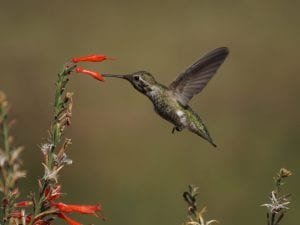A recent NYS Berry Growers Association newsletter highlighted Dr. Julie Carroll’s work on hummingbird interactions with spotted wing drosophila (SWD). Robin Catalano, author of the article, referenced two posts from Julie’s SWD blog. Today, we’re offering a taste (a one part water, four parts sugar taste), but encourage you to visit each post for more detail.

It all began when, in her 2014 blog post entitled Hummingbirds, Julie shared an article from Good Produce, Berry Growers Sharing Great Ideas by Charlie O’Dell: “Unusual Way to Control SWD”, one grower’s use of hummingbird feeders to attract these beautiful, pugnacious, and voracious birds. O’Dell wrote, “Robert Hays of Hays Berry Farms at Dumas, MS, installs 25 hummingbird feeders per acre in his six acres of blackberries and fills each with a plain, clear, sugar-water solution. He estimates there are more than 500 hummingbirds flying around his fields on picking days, some even landing briefly on pickers’ arms or hats. Between his beneficial insects and his hummingbirds, he has not had to spray.”
Do you know that hummingbirds will eat up to 2,000 small insects per day when feeding their young?
A hummingbird’s diet consists mostly of flower nectar and insects. Nectar provides sugar for their high metabolic rate, while insects provide protein, amino acids, and necessary vitamins and minerals. Besides fruit flies, hummingbirds consume (in one effective swallow) tiny beetles, flies, gnats and mosquitoes. To bring these beauties near, many people supplement natural nectar sources with a solution they purchase or mix on their own. It’s important to sterilize the feeders often or boil the solution to reduce yeast or bacterial growth. The warmer the temperatures, the more frequently the nectar should be changed. Oh, and skip the red dye.
Before commencing her field trial, Julie consulted The Cornell Lab of Ornithology’s FAQ’s . We suggest you do the same!
In short:
Use fairly small feeders at first, and change sugar water at least every couple of days. During hot, dry weather, when hummingbirds risk dehydration, it’s best to dissolve no more than a quarter cup of sugar per cup of water. (Up that to one third cup during cold, rainy weather.)
To reduce ant interference, use hummingbird feeders that have a center “moat”. Another option is coating the hanger rod with petroleum jelly.
Hummingbirds can consume 100 percent of their body’s weight in sugar water or nectar every day, in addition to as many as 2,000 tiny insects! Before migration, it’s not unusual for a hummingbird to double its weight, adding a huge amount of fat to power the long journey.
Because of competition for food, it’s best to set out a few small feeders rather than one large one. Adult males defend their territories during nesting season, so you’ll see fewer in midsummer when nesting females are busy incubating.
Hummingbirds as Pest Management Partners?
Over the last four years, Julie’s research in raspberry plots at Cornell AgriTech has shown promise as an alternative tactic to reduce SWD impact. Her recent post Hummingbirds May Reduce SWD addresses her findings.
Julie saw fewer SWD caught in traps where hummingbird feeders are located, compared to more being caught where there are no hummingbird feeders, in a transect along a raspberry planting.
Intrigued, a blueberry grower and a raspberry grower each gave it a try this past season to see if such an effort was feasible. Both growers cleaned the feeders and changed the sugar solution twice per week to keep the hummingbirds well fed and active within their plantings. Were they successful? We can tell you that, during a workshop held on one site, multiple growers considered adding this ‘tool’ to their pest management toolbox.
At the August, 2018 workshop held in Salem, NY, several of the tiny birds were seen dashing about.
Preliminary data analysis for 2018 shows that when SWD numbers are very low or very high, there is little to no difference in the number of SWD caught in Scentry traps placed in area of the field with hummingbird feeders compared to those in the area of the field without feeders. However, when numbers are moderate, there was a difference. Along a transect down the length of the field, the trend was fewer SWD in the hummingbird feeder area compared to the no-feeder area, as shown in the chart.
While placing and maintaining 25 hummingbird feeders per acre (the number of feeders used in her research) may be a bit arduous for some growers, there are other ways to attract hummingbirds to your berry planting. Allocate space for their preferred flowering plants, such as alternating rows of Monarda (bee balm).
Unfortunately, SWD “season” is much longer than that of our hummingbird helpers. When SWD populations explode in late summer, they remain difficult to control. By now, these lovely flying predators have likely flown South on their journey to the Yucatan peninsula in Central America.
What does this all mean to you? Growers like Robert Hays watched what was going on in his fields and tried something new. This is a key tenet of Integrated Pest Management. Scouting and using innovative methods and multiple approaches can work together to reduce pests and pesticide use.
Dr. Juliet Carroll, Fruit IPM Coordinator
NYS IPM Program, Cornell University, New York State Agricultural Experiment Station, 630 W. North Street, Geneva, NY 14456




